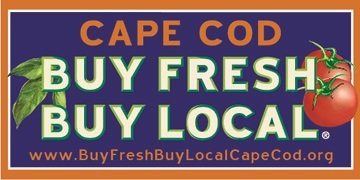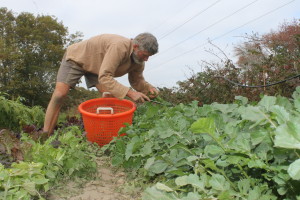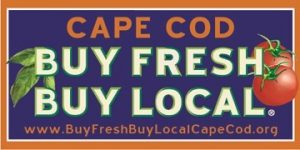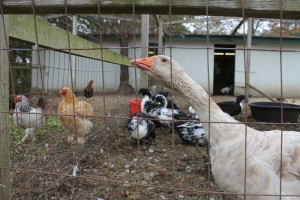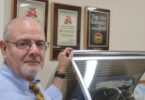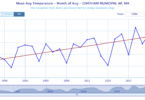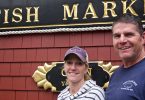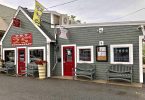FALMOUTH – Stan Ingram, the barefoot field manager of the Coonamessett Farm, reached down and picked a piece of late October arugula. “Even if it’s in your refrigerator in a bag for only one day, it’s not as fresh as this,” he said, and then he ate the arugula. “You lose nutrients over time.”
And while a day-old bag of farm fresh greens in a refrigerator may not stack up to eaten within seconds, it’s certainly better than a product grown under different and maybe unknown conditions 3,000 miles away, said Ingram.
Barnstable County’s Cape Cod Cooperative Extension Service is running a “Cape Cod Buy Fresh, Buy Local” marketing campaign with a $10,000 annual budget for meetings, a website, and marketing material such as the popular bumper stickers in order to get just that message out.
“Our mission is to connect people on Cape Cod with locally grown farm and sea products,” said Tasha Ramos, program coordinator.
The campaign to get people to eat fresh food grown locally is catching on. “Over the past number of years, we see more people on the farm – coming to the farm and getting stuff for dinner,” said Ingram.
The national “Buy Fresh, Buy Local” campaign is run by Foodroutes Network, based in Millheim, Pennsylvania. The Cape Cod chapter is essentially a franchise, explained Bill Clark, director of the Cape Cod Cooperative Extension.
Cape Cod had been part of the Southeastern Massachusetts chapter until a few years ago, said Clark, when “a group of farmers came to me and said what about starting our own Cape Cod chapter.”
The goal is to raise awareness. “This is a marketing campaign for locally grown products and businesses that sell locally-grown products,” said Clark.
And as Ramos explained, “It’s two sided, growers and buyers.”
And it benefits both.
“I’m an oyster farmer,” said Les Hemmila, the owner of Barnstable Sea Farms. “Local restaurants were buying their oysters from Connecticut to Canada. We’re trying to let them know we have a better product right here.”
The campaign, said Ramos, is a connector. “A lot of people out there say they’re doing local, but they’re really not,” she said..
Bill Atwood, owner/chef at the Red Pheasant Inn in Dennis said, “Years ago, we had a recall of spinach from salmonella. I had been buying a blend that had been marketed as a Massachusetts-grown mesclun mix. Well, the salmonella behavior was in California, but my spring mix had been recalled. When I asked my supplier why it had been recalled, he couldn’t give me an answer.”
So Atwood explained to his supplier, who he fired, “My reputation is on the line.” Now, “The first question I have is where was this grown? Where is this coming from? Is this a natural product?”
When consumers buy fresh and buy local on Cape Cod, sellers of local products get more customers. Buyers get a better product. And consumers?
“Everybody who does it does it for different reasons,” said Ingram. “They want to keep money in the local economy. And there are concerns about chemicals being used on food. When you buy fresh, buy local, you can come in and meet the person who is growing it. You can stop by and actually look at what they’re doing.”
Ingram hit on many of the same points cited by others. “It keeps dollars circulating in the local economy,” said Ramos. “It supports local agriculture. It helps keep open space on the Cape. In a tourist economy, it’s vital to retain our Cape Cod charm.”
And Atwood said, “I got a product that I know where it’s coming from and I don’t have to worry about who is altering the genetics.”
Ramos suggested another advantage is that consumers can reduce their carbon footprint by not eating food grown 3,000 miles away.
On the other hand, Atwood said sometimes he gets his food from very far away, including Australian lamb, and Faroe Island salmon from Norway. But whenever he can get a product on Cape Cod that meets his quality standards, he said, he gets it local.
“We are preserving farms, a native historical industry on the Cape,” said Clark. “Not only land-based farm, but sea-based farms as well. Shellfish farms. We are preserving a way of life, and we are preserving land.”
“The top restaurants are now using the local greens, the local vegetables, the local seafood, and they’re promoting that,” said Hemmila. “There definitely has been a change.”
And Ron Smolowitz, the owner of Coonamessett Farm, said, the local food movement gives the beginning of a backup disaster plan. “If you are totally dependent on a couple of companies to provide all of your food, you are totally susceptible to their whims,” he said.
Smolowitz said most people don’t explicitly pay attention to the nutrition they put in their body, but they should at least understand that, “Vegetables lose nutritional value as they travel. Large agricultural operations pick the product before it is ripe in order to get it to market with a longer shelf life. That’s 20 to 40 percent less nutritional value.”
Smolowitz’ 20-acre Coonamessett Farm is not a large agricultural operation. As Ingram, his field manager, said, “Some people like huge acreage and working with tractors. I tend to be smaller scale and doing a lot of hand work. I just like growing food for people.”
According to Clark, the largest farms on the Cape are the 40 acres at Tony Andrews Farm in East Falmouth, and the 60 acres at Crow Farm in Sandwich. Measuring how much farmland there is on Cape Cod is difficult, he said.
“The problem is how do you define a farm?” said Clark. “Is a horse farm a farm? What about the 1,100 acres of cranberries on the Cape?” In addition, he said, there are people who use a portion of their land to grow food and bring it to farmers markets. But he estimated there are about 200 full-time farms on the Cape.
Smolowitz said all farms do more than grow food. “We do weddings, We have the cafe. Virtually all the farms in the country have a second income source,” he said.
Still, farming is growing on the Cape, and in the state. “Massachusetts is one of the top agriculture states in the United States right now,” said Hemmila. “They are really promoting local agriculture.”
The locally grown movement “goes back to Alice Waters in Berkeley, California,” said Atwood, citing the owner of the legendary Chez Panisse restaurant.
Ingram explained, “I think the more people are connected to the food they eat, the more they understand. It’s like so many other things. You can buy something and look at it at face value,or you can try to understand what when into making it. If your clothes came from Bangladesh, what went into making it?”
He added, “If you, yourself, were to grow your own food, there’s a particular way you would want to do it.”
— Brian Tarcy

